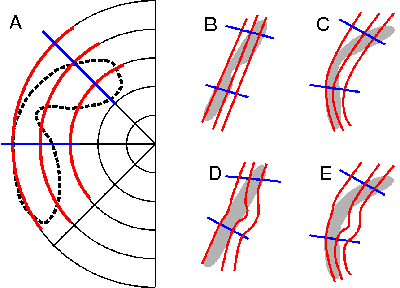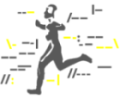





Search | Sitemap | Navigation |  |
|
||||||||||||||||||||||||||
|
||||||||||||||||||||||||||
|
||||||||||||||||||||||||||
|
Morphogenesis of Migraine Aura
In this subsection we summarize facts from morphogenesis rendering a sole vascular origin of the aura an unlikely explanation. Some spatio-temporal pattern experienced during the aura correspond to self-organized excitation pattern in neural tissue.
What happens Where?

Visualization of the mapping problem: What happens Where? © 2005 Markus Dahlem
Studying the morphogenesis of the aura is severely hampered by a fundamental problem. Usually we do not have a direct view on the pathophysiological brain activity. But in some cases, patients provide detailed descriptions of the aura symptoms, e.g. a drawing of the visual impairment. In these cases, a research question is how to derive from the description the two important factors governing their aura experience. Firstly, where in the brain is the disturbance located, and secondly, what exactly goes wrong there. [more]
Aura Pattern Explained by the Neural Theory

Lateral views of human brain with different time intervals after start of attack. Adapted from Lauritzen (1987) with permission.
A travelling wave is a typical pattern in excitable media such as neural tissue. Basic biophysical laws can predict important biochemical key elements. [more]
Aura Pattern Explained by the Vascular Theory
A cortical gradient in tolerating the deprivation of an indispensable substance may causes an spatio-temporal sequence of affection.[more]
Computer-assisted Aura Acquisition
Computer-assisted diagnostic procedures may in the future establish criteria based on the spatio-temporal development of the symptoms for deciding in which cases an aura is caused by a neural or a vascular disorder. [more]
References
Bures J, Buresova O, Krivanek J. The Mechanism and Application of Leao's Spreading Depression of Electroencephalographic Activity. Academic Press, New York 1974.
Dahlem MA, Müller SC. Reaction-diffusion waves in neural tissue and the window of cortical excitability. Annalen der Physik 2004; 13: 442-449.
Grafstein B. Neural release of potassium during spreading depression. In: Brazier MAB (ed) Brain Function: Cortical Excitability and Steady Potentials: Relations of Basic Research to Space Biology, vol. 1. University of California Press, Berkeley 1963, 87-124.
Grüsser OJ. Migraine phosphenes and the retino-cortical magnification factor. Vision Res 1995; 35: 1125-1134.
Lauritzen M. Pathophysiology of the migraine aura. The spreading depression theory. Brain 1994; 117: 199-210.
Author: Markus Dahlem
Last modification of this page: Sunday March 13. 2005
 Top of the page
Top of the page| · | News |
| · | Medical Professionals |
| · | Medical Studies |
| · | Classification of visual disturbances |
| · | Neurophysiological mechanisms |
Copyright © 2005 Migraine Aura Foundation, All rights reserved. Last modification of this site: August 25, 2006
Thanks to: RAFFELT MEDIENDESIGN and GNU software | webmaster@migraine-aura.org
http://migraine-aura.org/EN/Morphogenesis.html


